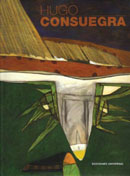An artist’s monographic book is not always breaking news. They do abound and usually pack a few wallops… The amazingly luring volume on Hugo Consuegra’s pictorial work is indeed an act of justice for Latin American culture –far beyond the conventional boundaries of ours, no matter how they might turn up– because the Cuban painter, a member of the larger-than-life Group of Eleven, is by and large one of the most peculiar ones creators the abstract expressionism of the 1950s and afterwards, with a sustained style until the year 2002, before his passing. The book deals with the still unresolved need of prying into the region’s isolated values and lays bare the vigorous character of the fine arts whose expression timeframe is still today. The monograph includes introit texts by Julio E. Hernandez Miyares: “Definitive Consuegra” and Ricardo Pau Llosa: “To dwell in passing: the art of Hugo Consuegra” plus the posthumous writings by Nicolas Quintana: “Parallel Lives: a personal compilation of Hugo Consuegra”, Armando Alvarez Bravo: “Hugo Consuegra: Art as Ecstasy,” and Lisset Martinez Herryman: “Hugo Consuegra: a close-up”. Substantial readings on the pictorial work and noticeable features of his intellectual projection. Quintana makes reference to his memoirs, Elapso Tempore, published in 2001. In addition to the two spaces of analytical-descriptive thinking on Consuegra’s painting –and speech– the book contains a thoroughly illustrated section with copies of catalog covers, invitation cards, pictures of groups and exhibition halls, plus the chronological listing of his activities –personal exhibits and participation in collective expositions– prizes and awards he grabbed along the way, plus his partaking in public collections. Another special section that depicts his professional and academic experience as an architect, highlighting his outstanding participation in projects that saw the light of day, most of them in New York City, is also in the volume. The graphic document, of course, is no doubt the nitty-gritty of the entire monograph. Regardless of the reproductions in keeping with Pau Llosa’s essay –it embraces half a dozen pieces from 1971 to 1998– the first part of the book is reserved to display his work on canvas (1953 to 2002) while the second half deals with his work on paper (1952 to 2002), plus an unfinished piece dated from 2003 which is highly interesting for its ingrained iconic values, its preparatory function and its formal quest of the painting. In his years of artistic takeoff –the first half of the 1950s– the visual field of Hugo Consuegra’s pictorial exercise is characterized by a composition of more lineal emphasis rather than massive splaying –a burden he carried as an architect- though the canvases of 1957 and 1958 show a qualitative leap ahead: audacity in the conception of forms and their spatial location, sober colorfulness, a preference for terra and dark reds, plain textures that are rough to the touch due to the trace of the paintbrush or the pigment porosity. In here, the accident is under control: the drawing of his abstract structure is from now on both thorough and elegant, and so it remained forever. There are three copies of completely unexpected representation; they show up as an “interruption” in his creative work, in his own evolution. They are dated in 1965 and raise eyebrows about their being the result of a mood shakeup the artist endured in the natural course of his sensitivity and daily goings in life. Yet they also stir suspicions about a critical consciousness that underlies in these images, reactive to a limited existential situation. In an effort to single out his artworks, they are figurative, his speech is cryptic, while his painting is open and only their headings make it look allegedly cryptic. In the 1970s –as a consequence of a change of life– Consuegra’s pictorial expression turned motley and whirly. During that period of time, those canvases of his included in the book make this point to a naked eye. Way into the 1980s, calmness set in. The composition of the painting wins back its former constructive conception of broad planes and isolated segments teeming with heavier drawing-like burden. The “Bon jour M. Balthus” (1984) canvas, marked by astounding austerity and quasi-geometric execution, could eventually appear to be the “gateway” to a new formal adventure the painter took on in the near future. A series of paintings made in the early 1990s, singled out for its square format and rhomboidal layout –and so splayed– represents a stimulant milestone for the creator that stretched out for quite some time as he switched among regular-size canvases into the late 1990s. The book picks up the latest examples of it in 1997. This particular period is typified by an organizational willingness of all formal elements, while his resorting to textures and rubbings have already either dwindled or faded away altogether. Hugo Consuegra’s abstract painting is far from being material and should not be penciled in as part of the out-and-out gestural language seen in the “action painting.” His work is definitely well thought out, even though the progression of his artworks is driven by a fortuitous “blow.” In it, the versatility of the drawing as a foundational principle meets the eye, while the rich and diverse color fits into that very principle. In the turn of millennia, a creative effort that still seems to give a whole lot more of itself is shut off in the middle of a promising moment. Let’s find in the making of this book the living biography of a legitimate artist. Hugo Consuegra: Lisset Martínez Herryman and Gustavo Valdes (editors), Ediciones Universal, Miami, 2006, 200 pages.

Related Publications

How Harumi Yamaguchi invented the modern woman in Japan
March 16, 2022












